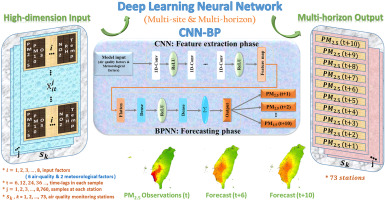Journal of Cleaner Production ( IF 11.1 ) Pub Date : 2020-03-26 , DOI: 10.1016/j.jclepro.2020.121285 Pu-Yun Kow , Yi-Shin Wang , Yanlai Zhou , I-Feng Kao , Maikel Issermann , Li-Chiu Chang , Fi-John Chang

|
The fine particulate matter (e.g. PM2.5) gains an increasing concern of human health deterioration. Modelling PM2.5 concentrations remains a substantial challenge due to the limited understanding of the dynamic processes as well as uncertainties residing in the emission data and their projections. This study proposed a hybrid model (CNN-BP) engaging a Convolutional Neural Network (CNN) and a Back Propagation Neural Network (BPNN) to make accurate PM2.5 forecasts for multiple stations at multiple horizons at the same time. The hourly datasets of six air quality and two meteorological factors collected from 73 air quality monitoring stations in Taiwan during 2017 formed the case study. A total of 639,480 hourly datasets were collected and allocated into training (409,238, 64%), validation (102,346, 16%), and testing (127,896, 20%) stages. The forecasts of PM2.5 concentrations were first characterized as a function of air quality and meteorological variables. Then the proposed CNN-BP approach effectively learned the dominant features of input data and simultaneously produced accurate regional multi-step-ahead PM2.5 forecasts (73 stations; t+1−t+10). The results demonstrate that the proposed CNN-BP model is remarkably superior to the BPNN, the random forest and the long short term memory neural network models owing to its higher forecast accuracy and excellence in creating reliable regional multi-step-ahead PM2.5 forecasts. Besides, the CNN-BP model not only has the power to cope with the curse of dimensionality by adequately handling heterogeneous inputs with relatively large time-lags but also has the capability to explore different PM2.5 mechanisms (local emission and transboundary transmission) for the five regions (R1-R5) and the whole Taiwan. This study shows that multi-site (regional) and multi-horizon forecasting can be achieved by exactly one model (i.e. the proposed CNN-BP model), hitting a new milestone. Therefore, the CNN-BP model can facilitate real-time PM2.5 forecast service and the forecasts can be made publicly available online.



























 京公网安备 11010802027423号
京公网安备 11010802027423号